Book contents
- Frontmatter
- Contents
- Preface to the First Edition
- Preface to the Second Edition
- Mathematical Prolegomenon
- Part I Propositional Logic
- 1 Classical Logic and the Material Conditional
- 2 Basic Modal Logic
- 3 Normal Modal Logics
- 4 Non-normal Modal Logics; Strict Conditionals
- 5 Conditional Logics
- 6 Intuitionist Logic
- 7 Many-valued Logics
- 8 First Degree Entailment
- 9 Logics with Gaps, Gluts and Worlds
- 10 Relevant Logics
- 11 Fuzzy Logics
- 11a Appendix: Many-valued Modal Logics
- Postscript: An Historical Perspective on Conditionals
- Part II Quantification and Identity
- Postscript: A Methodological Coda
- References
- Index of Names
- Index of Subjects
1 - Classical Logic and the Material Conditional
Published online by Cambridge University Press: 05 June 2012
- Frontmatter
- Contents
- Preface to the First Edition
- Preface to the Second Edition
- Mathematical Prolegomenon
- Part I Propositional Logic
- 1 Classical Logic and the Material Conditional
- 2 Basic Modal Logic
- 3 Normal Modal Logics
- 4 Non-normal Modal Logics; Strict Conditionals
- 5 Conditional Logics
- 6 Intuitionist Logic
- 7 Many-valued Logics
- 8 First Degree Entailment
- 9 Logics with Gaps, Gluts and Worlds
- 10 Relevant Logics
- 11 Fuzzy Logics
- 11a Appendix: Many-valued Modal Logics
- Postscript: An Historical Perspective on Conditionals
- Part II Quantification and Identity
- Postscript: A Methodological Coda
- References
- Index of Names
- Index of Subjects
Summary
Introduction
1.1.1 The first purpose of this chapter is to review classical propositional logic, including semantic tableaux. The chapter also sets out some basic terminology and notational conventions for the rest of the book.
1.1.2 In the second half of the chapter we also look at the notion of the conditional that classical propositional logic gives, and, specifically, at some of its shortcomings.
1.1.3 The point of logic is to give an account of the notion of validity: what follows from what. Standardly, validity is defined for inferences couched in a formal language, a language with a well-defined vocabulary and grammar, the object language. The relationship of the symbols of the formal language to the words of the vernacular, English in this case, is always an important issue.
1.1.4 Accounts of validity themselves are in a language that is normally distinct from the object language. This is called the metalanguage. In our case, this is simply mathematical English. Note that ‘iff’ means ‘if and only if’.
1.1.5 It is also standard to define two notions of validity. The first is semantic. A valid inference is one that preserves truth, in a certain sense. Specifically, every interpretation (that is, crudely, a way of assigning truth values) that makes all the premises true makes the conclusion true. We use the metalinguistic symbol ‘⊧’ for this. What distinguishes different logics is the different notions of interpretation they employ.
- Type
- Chapter
- Information
- An Introduction to Non-Classical LogicFrom If to Is, pp. 3 - 19Publisher: Cambridge University PressPrint publication year: 2008



